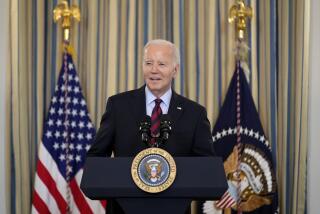Counting Calories . . . Again
- Share via
Calories are back.
Not that they ever really disappeared, but somewhere in the fat-free frenzy, some of us lost sight of one of the laws of thermodynamics. People ate fat-reduced cookies, crackers and cakes, and the calories added up. They didn’t lose weight. Maybe they even gained.
Now Nabisco is splashing calorie comparisons on some of its SnackWell’s packages. Other food companies have calorie-reduced foods in the works. The Calorie Control Council, which represents the “lite” food industry, has mounted a “Calories Still Count” campaign. And health authorities are realizing that their simple message to “reduce fat” may have been too simple.
“Calories are definitely back,” says John Foreyt, director of the Nutrition Research Clinic at the Baylor College of Medicine in Houston, where he has started counseling patients to count calories again, not just grams of fat.
Those frustrated with nutritional flip-flopping may see the return to calories as just another reason to throw up their hands. But here’s how it happened: Health authorities originally told Americans to slash fat from their diets to lower the risk of heart disease and cancer. People then looked to fat reduction as the solution to obesity too.
And the scientific community is partly to blame, says Nancy Ernst, nutrition coordinator of the government’s National Cholesterol Education Program. Epidemiological studies showed that lower fat consumption translated to weight reduction, she said. But there were no data showing whether in a food market like the United States, eating less fat would necessarily equate with eating fewer calories.
Subjects in the studies ate foods naturally lower in fat (and calories), like fruits, vegetables and grains, not reduced-fat cookies and crackers.
In the real world, an aggressive food industry went gangbusters marketing the fat-reduction concept, even though in some cases those lower-fat desserts and snacks have negligible reductions in calories (more sugar or other carbohydrates are added to replace the fat). Then there’s the American tendency to want it all, especially when it’s fat-free.
The ironic conclusion to all this attention to nutrition is that Americans keep getting fatter. No wonder: We’re eating more calories.
Still, calorie consumption has not risen enough to account for all of the rise in obesity, said Sue Borra, a dietitian with the International Food Information Council, a nonprofit group funded by the food industry. People have become less active. That’s why in this round of calorie counting, the emphasis is on calories expended, Borra said. That means exercise.
Meanwhile, some in the food industry are looking at calories consumed, or at least marketing the idea. Nabisco recently put calorie-comparison claims on six SnackWell’s cracker and cookie packages as well as on Newtons Cobblers and fat-free blueberry and cranberry Newtons. These products have not been reformulated.
Most people aren’t going to understand what’s being compared, however. And even if they do, the calorie differences aren’t very significant. For example, the label of SnackWell’s Devil’s Food Cookie Cakes says they have “35% less calories than the leading cookie.” Not the leading devil’s food cookie, mind you (that’s SnackWell’s itself), but the best-selling cookie overall. Right now, that’s Oreos, and the calories in equal weights of Devil’s Food and Oreo were compared.
Still, people don’t eat cookies by weight. They eat them by unit. One SnackWell’s cookie is 50 calories; one Oreo is 53.
Ann Smith, spokeswoman for Nabisco, says the labeling comparisons follow government rules. Furthermore, Nabisco is developing new products that do focus on fewer calories, not just on less fat. “It’s the next wave,” Smith said.
Abraham Bakal, president of ABIC International Consultants, a New Jersey firm that does product development for some of the country’s largest food companies, says ABIC is “involved in a lot of activities” to reduce calories in packaged foods.
“These things go in cycles,” Bakal says. “Especially in our country.”
Although Nabisco’s market research showed that people want not only fat-reduced but calorie-reduced products, others think consumers haven’t quite reconciled the two.
“I don’t feel comfortable saying that the calorie message has made an impact,” says Robyn Flipse, a dietitian in Ocean, N.J. “People are still looking for another magic formula without approaching food in a more holistic way.”
Anne Marie Johnson, senior brand manager for Keebler cookies, agrees that consumers “aren’t there yet” when it comes to putting calories and fat together. Keebler had a calorie-reduction claim on the front of its now-defunct Fruitastics cookies, but people didn’t value it as much as fat reduction, Johnson says. Part of it may be that cookies are so high in calories anyway, she said.
Nonetheless, Johnson says that calorie claims are definitely an emerging trend, but that in the meantime, Keebler will watch and wait. “We look to Nabisco to lead the education train,” she says. “They have a lot more money than we do.”






